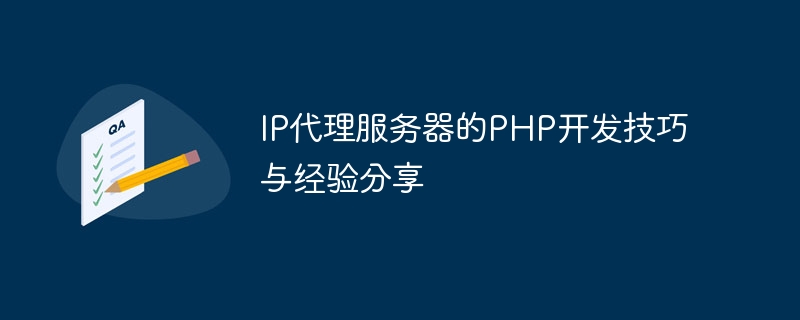Home >Backend Development >PHP Tutorial >PHP development skills and experience sharing for IP proxy servers
PHP development skills and experience sharing for IP proxy servers
- WBOYOriginal
- 2024-03-10 14:48:031013browse

IP proxy server is a commonly used network tool used to hide the user’s real IP address and bypass some restrictive access controls, thereby achieving a freer and more convenient network. Access experience. In the process of developing IP proxy servers, PHP is a commonly used server-side programming language with the advantages of being easy to learn and highly flexible. Therefore, in this article we will share some PHP development skills and experience of IP proxy servers, and also attach Some specific code examples are provided to hopefully help readers better understand and apply them.
1. Build a basic IP proxy server
First, we need to build a basic IP proxy server to realize the function of forwarding user requests and hiding the user's real IP address. In PHP, we can use the cURL library to achieve this function. The following is a simple example of setting up an IP proxy server:
<?php
// 客户端请求的URL
$url = 'http://example.com/api/data';
// 代理服务器地址和端口
$proxy = 'http://proxyserver.com:8888';
$ch = curl_init();
curl_setopt($ch, CURLOPT_URL, $url);
curl_setopt($ch, CURLOPT_PROXY, $proxy);
curl_setopt($ch, CURLOPT_RETURNTRANSFER, true);
$response = curl_exec($ch);
if($response === false) {
echo 'Error: ' . curl_error($ch);
} else {
echo $response;
}
curl_close($ch);
?>In the above example, we specify the address and port of the proxy server by setting the CURLOPT_PROXY option to implement request forwarding. In this way, when a user accesses http://example.com/api/data, the actual request will be sent to the proxy server first, and then the proxy server will forward the request and return the data to the user, achieving IP proxy function.
2. Add IP address filtering mechanism
In order to improve the security of the IP proxy server, we can add an IP address filtering mechanism to only allow specific IP addresses to access the proxy server. Below is a simple IP address filtering example:
<?php
// 允许访问的IP地址列表
$allowed_ips = array('192.168.1.1', '10.0.0.1');
// 获取访问者IP地址
$client_ip = $_SERVER['REMOTE_ADDR'];
// 检查IP地址是否在允许列表中
if(in_array($client_ip, $allowed_ips)) {
// 如果在允许列表中,则处理请求
$url = $_GET['url'];
$proxy = 'http://proxyserver.com:8888';
$ch = curl_init();
curl_setopt($ch, CURLOPT_URL, $url);
curl_setopt($ch, CURLOPT_PROXY, $proxy);
curl_setopt($ch, CURLOPT_RETURNTRANSFER, true);
$response = curl_exec($ch);
if($response === false) {
echo 'Error: ' . curl_error($ch);
} else {
echo $response;
}
curl_close($ch);
} else {
// 如果不在允许列表中,则拒绝访问
echo 'Access denied';
}
?>In the above example, we first get the visitor's IP address and then check if the IP address is in the list of allowed IP addresses and if it is in the list Then access is allowed, otherwise access is denied.
3. Processing proxy server logs
In order to monitor and analyze access to the proxy server, we can add a logging function. The following is a simple logging example:
<?php
// 记录访问日志
function log_access($ip, $url, $timestamp) {
$log_file = 'access.log';
$log_entry = "$ip - $url - $timestamp";
file_put_contents($log_file, $log_entry . PHP_EOL, FILE_APPEND);
}
$url = $_GET['url'];
$timestamp = date('Y-m-d H:i:s');
$client_ip = $_SERVER['REMOTE_ADDR'];
$proxy = 'http://proxyserver.com:8888';
$ch = curl_init();
curl_setopt($ch, CURLOPT_URL, $url);
curl_setopt($ch, CURLOPT_PROXY, $proxy);
curl_setopt($ch, CURLOPT_RETURNTRANSFER, true);
$response = curl_exec($ch);
if($response === false) {
echo 'Error: ' . curl_error($ch);
} else {
echo $response;
log_access($client_ip, $url, $timestamp);
}
curl_close($ch);
?>In the above example, we defined a log_access function to record the access log. This function will be called after each request is completed to record the access. information to the access.log file.
4. Conclusion
Through the sharing of this article, I hope readers can understand the basic functions of the IP proxy server and its implementation method in PHP. At the same time, it is recommended to strengthen the consideration of security measures such as IP address filtering and access logging during the development process to ensure that the proxy server can operate safely and stably. If you have any questions or doubts, please leave a message for discussion, thank you for reading!
The above is the detailed content of PHP development skills and experience sharing for IP proxy servers. For more information, please follow other related articles on the PHP Chinese website!

